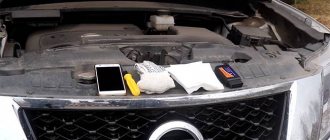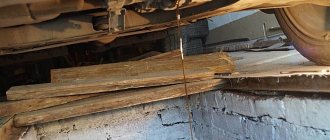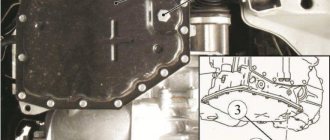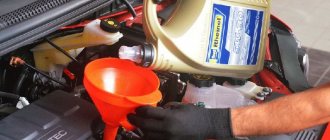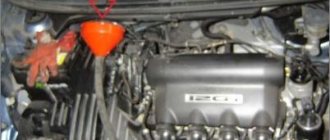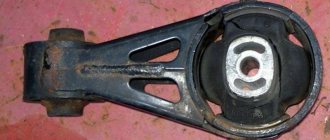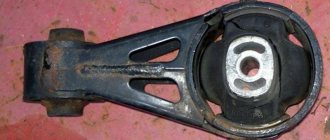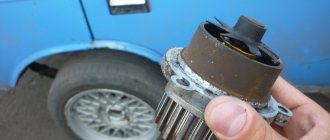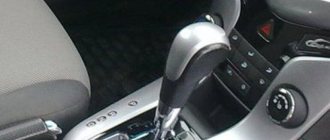A variator (CVT) is often installed on modern Nissan cars, since the operational and technical characteristics are higher in comparison with manual transmissions and automatic transmissions. In order for the mechanism to function smoothly, it is necessary to timely measure the oil level and, if necessary, raise it to the recommended parameters. It is especially important to know this indicator if a leak is detected or suspected.
Nissan Qashqai Englishman › Logbook › Checking the oil level of the Nissan Qashqai J11 variator without a dipstick.
I searched for a long time, but never found a video on how to correctly set the oil level in a variator without a dipstick. I had to resort to information from the service manual. I recorded a short video: “Checking the oil level in the Nissan Qashqai J11 variator.” The video quality is not very good, but I think it’s clear what needs to be done.
A little later I will post a detailed video: “Complete oil change in the variator.” In this video I will bleed the valve body and oil cooler, as well as replace the fine filter and clean the coarse filter. All the best!
How to extend the life of a variator?
The resource of Nissan CVTs is very limited, so the question of extending it is quite appropriate. The following recommendations can be given:
- In winter, the car must warm up; you should not move away without warming up.
- The sensors need to be checked periodically and cleaned if necessary; errors generated by the on-board computer should not be ignored.
- When servicing the variator, it is necessary to clean the radiator.
- It is advisable to completely replace the lubricant in the CVT; add it only when a low level is detected.
- The driving style should be calm - sharp accelerations and prolonged driving at high speed shorten the service life of the variator.
- You should not use a car with a CVT to tow other vehicles.
Fine filters for Nissan variator
Storage conditions for transmission fluid must be strictly observed. It is better to carry out lubricant replacement work indoors to prevent debris from entering.
Filters must be changed after 60,000 km.
Recommendations
Comments 29
Hm. No dipstick? Is there a tube for it? I remember once upon a time I saw on forums that Mitsubs with a CVT also did not have a dipstick. We bought it separately at the existential store, installed it and were happy. Maybe that's the case here too?
This won’t work here, people have already ordered a dipstick on Exist several times using the number, but in the end they receive a plastic plug. Some people still do it according to the principle: as much as was drained, so much was poured in. But this is not entirely true, because... It is not known whether the level was correct before draining the oil.
It may well be that the same variator, but a different make of car, has a dipstick. Haven't you looked?
So far, no probe fits without modification.
Even if you completely drain the fluid from the variator and then unscrew the control plug, everything will be the same as in the video. Only what was in the channel above the plug was drained. Repeat the procedure, but at the same time add to the tube for the dipstick (which is not there) until it really starts to leak.
That’s right, I first filled in more liquid than needed, and then drained it until it was a thin, intermittent stream. The manual says: “when the CVT fluid flow slows to a drop.”
Content
A CVT is similar to an automatic gearbox in that you do not need to set the speed yourself using the transmission lever. However, in its operation it has significant differences: if the “automatic” includes fixed gears, usually in the number of four to nine, then the variator is a continuously variable transmission that does not have fixed steps.
In other words, if an automatic transmission alternately includes fixed stages, then the variator works from the lower to the upper threshold, without having intermediate “stops” on the way to increasing the gear ratio.
So, in what ways can the variator be checked if you have already met with the seller and are inspecting the car:
- Checking the oil in the variator;
- Check in motion;
- Sound check.
The second and third methods may seem similar, but they are only adjacent; one may not give a complete picture without the other.
Despite the fact that a standard “automatic” with a torque converter is considered the preferred transmission option, a variator is considered more modern, although it is not without its flaws and shortcomings, and in some ways is inferior to an automatic transmission.
Let's talk in more detail about ways to check the variator.
Checking the oil level in the Nissan variator
To check the oil level in the CVT on a Nissan (Qashqai j10 X-Trail T30), you need to warm up the lubricant. In warm weather, you will need to drive about ten kilometers for the oil temperature to reach 50-80 C, while in winter you will need to drive 25 km. If the oil is too hot, let it cool.
Stages of checking the oil level in a Nissan variator with a dipstick
- Vehicles are installed on a horizontal surface - tilting is not allowed. The check is performed with the engine idling.
- Alternately, the lever is switched in each position (P, R, N and D) by pressing the brake pedal and held for five to ten seconds. After this, the variator is set to mode P and the brake is released.
- You need to open the hood and remove the dipstick from the variator neck, marked “Transmission” or CVT. To release the oil level dipstick, press the locking latch. To avoid getting dirty, it is recommended to arm yourself with special gloves or rags in advance.
- After removing the dipstick, it is necessary to thoroughly wipe it dry with a clean rag that does not leave small particles or threads, since they, as well as moisture, can lead to all sorts of problems if they get inside the variator.
- The cleaned dipstick is lowered into the neck completely without snapping the latch and is held there for five to ten seconds. After removal, a trace of oil remains on it, indicating the real level.
- The dipstick has marks for the highest and lowest permissible levels. Ideally, the oil trace on the surface of the dipstick should be in the HOT range. On different Nissan Qashqai j10, Teana models, the mark may be indicated “add – 1pt” or “don’t – full – max”.
- After determining the existing oil level in the variator, the dipstick is lowered back into the neck and securely fixed with a latch. The check is completed.
The procedure is simple and even Nissan drivers with little experience can easily cope with it. It is important that the engine does not stop idling during the procedure.
What to do if there is no dipstick?
On models Nissan JUKE, Qashqai j11, X-Trail T32 or other variations, there is a plug instead of a dipstick. In this case, checking the oil level will be more difficult. Most often, for this purpose, they contact an authorized service center, where the procedure is performed by specialized specialists.
Those who do not want to, cannot urgently drive to a service station or want to save money, can try to check the amount of oil by draining it. The variator is equipped with a special control hole (filler hole). The box must be heated to forty degrees, and the control must be unscrewed (with the engine running). Oil begins to flow out of the channel in a thin stream. If it does not flow, you need to add until oil appears. Then the plug is screwed in and the procedure can be considered complete.
We make the dipstick ourselves
If the second method seems too complicated and time-consuming, then you can make the probe yourself. First you need to remove the plug in the place where the dipstick should be located. Next, you need to measure the depth from the edge of the box to the pallet. You can do this using a metal cable and try to find a compatible probe of the right size. An oil meter can be purchased from another Nissan model.
Sometimes they encounter a difference in length, but the dipstick can be shortened and glued into the car plug. This way, measuring the oil level in the variator will no longer be a problem.
The main reasons for the failure of the variator on the Nissan Qashqai
As we have already said, not many people still believe in the reliability of CVTs. There is an opinion that they are very capricious, and it is not advisable to repair them due to the high cost of components. Official dealers practically do not carry out repairs; in most cases, a broken variator is simply replaced with a new one, the cost of which will shock the owners. By the way, the same fate awaits the owners of conventional hydromechanical “automatic machines”. Despite this, some workshops, taking advantage of the current situation, have mastered the repair of CVTs. Information from one of the representatives of such a service was used when writing this publication, which we hope will dot the i’s. To a greater extent, Jatco CVTs can be found on cars of the Renault - Nissan concern; one of the common models is JF011E. Such a variator is most often installed on the Nissan X-Trail in the T-31 body, as well as on the Qashqai and Teana. Manufacturer Renault equips JF011E for Megan, Latitude, Fluence, Scenic and Koleos cars.
Also, Jatco CVTs are often used for their models by Mitsubishi (Lancer, Outlander) and the French manufacturers of cross-platform crossovers Citroen C-Crosser and Peugeot 4008. But that’s not all. Jeep Compass, Suzuki Kizash, Dodge Caliber are also equipped with Jatco JF011E CVTs. Using this model as an example, we will tell you what diseases are found in continuously variable transmissions.
Consequences of a lack and excess of oil in a Nissan variator
The variator can function fully only when the oil level meets the requirements of technical regulations. Any deviations in the direction of overfilling or underfilling can cause the occurrence and development of malfunctions of the box itself and difficulties in driving the car.
Underfilling or overfilling transmission fluid is highly undesirable.
Consequences of underfilling
If there is insufficient oil in the box, metal shavings begin to form due to excessive friction of the parts. The oil pump becomes clogged, which easily leads to failure of both the pump itself and the variator. These problems can arise several years later when the warranty expires, but it is not uncommon for the transmission to need to be replaced within a couple of months after purchasing the car.
If, after checking, it is discovered that the oil does not reach the minimum permissible mark, it is necessary to urgently add the required amount, and not put the problem on the back burner. Delaying the time to solve the problem leads to wear of parts and breakdown of the variator, the replacement of which is expensive. However, you need to add it very carefully, since you cannot allow the oil to overflow.
Oil check
The variator box, or CVT as it is called, contains a special fluid - oil, which allows the box to operate smoothly and silently. Checking the fluid in the variator is the most reliable way to obtain comprehensive information about the condition and performance of the transmission.
Checking the oil is carried out in the same way as, say, on an engine - using the usual oil dipstick. However, it is important to take into account that in the case of a variator, the oil must be checked with two marks on the dipstick, one is responsible for the “cold” condition, the other - when the variator is warm.
Checking the level and changing the oil in the Nissan Qashqai variator yourself
The CVT transmission is a continuously variable transmission that differs from traditional automatic transmissions in the absence of gears. Nissan Qashqai cars with such gearboxes smoothly pick up speed without increasing engine speed or jerking. To ensure proper operation of the unit, it must use high-quality lubricant. Therefore, in this article we suggest finding out how and how often the oil is changed in the Nissan Qashqai variator.
When is an oil change required?
Consequences of untimely replacement
Level control and required volume
How to change the oil yourself?
Tools and materials
Video “How to pump out and fill new oil into a variator using a compressor?”
Comments and Reviews
What kind of variator is installed on Nissan Qashqai
Nissan Qashqais with an automatic transmission are equipped with a new generation CVT transmission, developed by the Japanese manufacturer together with Jatco specialists. When setting up this system, Nissan engineers took the Multitronic transmission from Audi as a basis.
The new generation of traditional V-belt CVTs is complemented by improved components that will reduce the size of the entire system by 10% and significantly reduce the weight of the unit. Next, we will briefly consider the principle of operation of the Nissan variator.
The principle of operation of a CVT gearbox is to simultaneously change the dimensions of the diameters of the drive and driven shafts. The diameter sizes are changed using a special drive depending on the operating modes of the engine. When the car starts moving, the drive shaft of the box has a minimum diameter, and the driven shaft has a maximum diameter.
When the vehicle accelerates, as the engine speed increases, the diameter of the CVT drive shaft begins to increase. At the same time, the diameter of the driven shaft decreases, resulting in a reduction in the gear ratio. If the car accelerates on the road, the CVT maintains optimal speed, which provides the greatest power and excellent dynamics of the car.
This is interesting: How many liters of oil are in a VAZ 21083 engine
When is an oil change required?
First, let's look at how often the lubricant and filter are changed in the transmissions of Qashqai cars of 2008, 2012, 2014 and other years of production. According to the regulations, it is necessary to carry out the lubricant replacement procedure every 60 thousand kilometers. It must be taken into account that CVT transmissions are sensitive to off-road operation and to operating the vehicle on rough roads. This leads to rapid wear of the structural elements of the gearbox. Therefore, experts recommend changing the lubricant earlier, at least every 45 thousand km, or better yet, every 30 thousand km.
Check in motion
Like many other components, assemblies and car parts, the CVT has a set of features that will tell you a lot, you just have to drive the car a little. If you meet the seller of a car equipped with a CVT, do not hesitate to ask him for a short test drive.
Ideally, of course, “drive” the car from the lower to the upper threshold. Simply put, if the car accelerates smoothly and without jerking to 180 kilometers per hour, this indicates the unequivocal serviceability of the variator. However, we do not recommend doing this unless you have a race track nearby and the car owner agrees to such a stressful test.
If the car jerks or does not accelerate smoothly, this indicates a malfunction. Most likely, the culprit is the oil pump, which is clogged with worn-out metal shavings from the wearing out variator mechanism. If it clogs the valves, the pump begins to jam, which leads to surges in oil pressure in the system.
The coherence of the movement of the pulleys is lost, the belt slips, and the car jerks. It is extremely risky to buy a car with such symptoms, because if the owner has driven in this mode for a long time, it is very likely that the gearbox will be quickly replaced, which is not cheap (on an Audi, the cost of the CVT itself is approximately 100 thousand rubles).
The variator belt itself is a set of metal plates, on which, for better adhesion to the pulleys, microscopic irregularities are applied. Mechanically, they are erased over time, becoming the very dust that can clog systems. If the box twitches, it is better to refuse to buy the car, and recommend to the owner to open the variator as soon as possible.
Consequences of untimely replacement
If you do not follow the transmission fluid change intervals in the Qashqai CVT, this may lead to transmission failure.
The first symptoms that indicate that problems will soon appear in the operation of the unit and it’s time to change the oil:
- Difficulties arose when switching gear modes. When you activate the gearshift lever to a different position, shocks and jerks may appear.
- The transmission takes longer to warm up. When a lubricant loses its properties, it cannot handle all rubbing parts and mechanisms. It takes more time for it to enter all channels and lines of the transmission system.
- When switching modes, extraneous noise, hum, or rattle will occur. This indicates insufficient lubrication of the structural elements of the transmission.
- The appearance of vibration in the area of the gearbox selector.
- Engine power decreases. CVT transmissions operate without gear shifting. If the unit cannot develop enough power to activate the next position, this will also affect the power of the machine's motor.
- Due to lack of lubrication, rubbing parts will wear out faster. As a result, wear products in the form of metal shavings will begin to clog the channels of the transmission system. This will lead to a lack of pressure, which will affect the functionality of the unit as a whole.
- A lubricant leak has occurred.
- The lubricant in the Nissan CVT has become too dark, and traces of deposits and wear products have appeared in it.
- There is an unpleasant burning smell coming from the transmission fluid.
How to change the oil yourself?
You can change the transmission oil in a Qashqai automatic transmission yourself or with the help of specialists at a service station. We will tell you how to properly perform a complete lubricant change with your own hands.
Tools and materials
What you will need to complete the task:
- fresh oil, 2 cans are required for a full change;
- a set of wrenches and open-end wrenches;
- flat head screwdriver;
- a cut-off bottle or bucket into which used oil will be drained;
- clean rags;
- watering can;
- new sealing rubber for the CVT pan, the old one is damaged during dismantling;
- a special product or diesel fuel for cleaning the pan and filter device;
- a new coarse mesh filter, if the installed mesh cannot be washed.
User Evgeniy Lipovka showed in his video how the procedure for changing the lubricant in a Nissan Qashqai CVT transmission is performed.
Stages of work
Replacing consumable fluid is done as follows:
- The vehicle is driven into a garage with a pit or onto an overpass. To make the lubricant more fluid, the car engine warms up to operating temperature.
- Get under the bottom of the car and remove the crankcase protection. Please use the service book before performing the procedure. The protection is fixed with bolts or special fasteners.
- Unscrew two more screws located on the front part in the subframe area. The procedure is performed with an open-end wrench.
- Remove the four pistons located on the sides and one on the front. To dismantle, pry up part of the part in the middle and pull it down, so you can remove the lock.
- Check the lubricant level in the transmission unit. We talked about level control above. Volume diagnostics must be carried out during a change. This is done so that in the event of a leak, the car owner knows that there is a problem. If there really is a leak, the gearbox housing, oil seals and seals are diagnosed. All damaged items must be replaced.
- If the lubricant level is normal, crawl under the bottom of the car and find the drain plug. Before draining, place a container underneath to collect the waste substance. Unscrew the plug with a wrench and wait until the oil drains from the gearbox.
- If it is necessary to replace the pallet gasket, dismantle the product; to do this, unscrew all the screws that secure it. There may be some oil in the pan. When dismantling it, be careful not to spill the lubricant on yourself.
- There are two magnets installed inside the tray. Assess their condition, as well as the condition of the used lubricant in general. The magnets must be cleaned of wear products in the form of metal shavings. For cleaning, you can use a special cleaner or acetone.
- Remove the filter and clean it. The filter device is replaced if the cleaning procedure does not produce results. Reinstall the filter, as well as the magnets in the tray. Get rid of the remnants of the old seal around the perimeter of the pan. Install a new rubber band, treating the seat with sealant. Reinstall the tray, securing it securely with the bolts.
- Place a funnel in the hole and pour fresh lubricant through it. When the oil is filled, check the level of the substance and take a test drive. Measure the amount of lubricant in the system again.
Lubricant selection
Original oil for Qashqai variator
In order for the J11 CVT transmission or other Nissan gearbox to work without interruptions, only high-quality lubricant must be poured into it. Using low-quality transmission fluid will lead to transmission malfunctions.
The manufacturer recommends pouring original Nissan CVT Fluid NS-2 lubricant into Kashkaev gearboxes.
To avoid purchasing a counterfeit product, when purchasing, pay attention to the code indicated on the label. For original products it is KLE52-00004. In principle, it is also possible to use other analogues if you cannot buy the original product. But the manufacturer recommends not to experiment.
Which oil to choose for Nissan cars?
The original oil in the Nissan variator has the following markings: CVT NS-1, CVT NS-2, CVT NS-3. NS-1 is a first generation synthetic designed for Jatco continuously variable transmissions. It is poured into the boxes of Nissan cars produced before 2006 - Primera, Cube, March, etc.
NS-2 was developed for Hyper CVT gearboxes installed on cars after 2006 - Qashqai, X-Trail, Teana, Murano, Note, etc.
NS-3 will be required for 2012-2013 cars. release with continuously variable transmission. Used for the following Nissan models - Pathfinder, Teana, Serena, Altima.
Other manufacturers of CVT oil
Filling a Nissan CVT with non-original fluid is a risky undertaking. Incompatibility with factory lubricant, lack of necessary additives affects the service life of the box, and its repair is an expensive procedure. There are several analog options on sale that have proven themselves among Nissan car owners:
Idemitsu CVTF - designed for Jatco CVTs. In the list of relevant fluids, the manufacturer indicates the entire line of Nissan transmission fluids. Ravenol CVTF NS2/J1 Fluid is an oil of German origin, designed for use in JF010E and JF011E CVTs. A distinctive feature is green color. Nissan models for which the fluid is designed are Qashqai (Dualis), X-Trail, Serena, Lafesta. Febi Bilstein CVT is another German brand that is officially supplied to the Mercedes-Benz auto concern. The manufacturer claims the oil is compatible with original fluids for Nissan CVTs.
CVT Jatco JF15
Level control and required volume
The Nissan Qashqai transmission unit will contain 8 liters of oil.
Before performing the replacement procedure, you need to check the level and quantity of the substance in the unit.
Meter for monitoring lubricant volume
The test is performed on a flat horizontal surface:
- Start the car engine and let it idle.
- Press the brake pedal and move the gear shift lever in turn to all modes - P, R, N, D. You must hold in each position for 10 seconds.
- Place the gear shift lever in position P and release the brake pedal.
- Open the hood of the car.
- In the engine compartment you can see part of the CVT transmission. A dipstick can be seen from the inspection hole. The neck you need should have the inscription TRANSMISSION or CVT, depending on the modification of the vehicle.
- Remove the dipstick and wipe it with a cloth. There should be no grease particles on it. In this case, the rag must be clean so that dirt does not get inside the unit. If precipitation falls outside in the form of snow or rain, then it is better to refrain from the inspection procedure or perform it in the garage. Water getting into the transmission can also cause problems.
- Once the meter is clean, replace it in the hole and push it all the way in. Wait a few seconds and remove the dipstick. There will be traces of oil on the meter, which indicate its level in the system. If the volume of substance in the gearbox is normal, the lubricant level should be between the minimum and maximum marks, in the area of the HOT inscription. There may not be such a mark on the dipstick. Often the ADD mark indicates that the lubricant level is minimal, and DON'T - FULL - maximum. Once the diagnosis is complete, the meter is pushed into place until the latch engages.
A meter for level control is not available in all car modifications. To diagnose without a dipstick, you need to find the filler hole on the gearbox. Find the hole and unscrew the plug. The volume of lubricant should be at the level of the lower edge of the hole.
The Mirage Motors channel published a video demonstrating the procedure for replacing transmission fluid in a Qashqai CVT transmission.
If the oil level is less
If you find that your oil level is at or below a critical level, you need to urgently add fluid. For this purpose, in fact, the fluid level in the variator is checked on the Nissan Qashqai. The brand of oil, or its characteristics for choosing an analogue, is always indicated in the user manual. It is necessary to fill in oil of equivalent characteristics.
You can see the mark left by the oil on the opposite end of the handle: the level should be between the two notches. General method, cold engine and shutdown. Stop the car on a horizontal surface, wait four to five hours after stopping the engine so that all the oil has time to drain into the crankcase, including the torque converter oil.
Open the engine cover, find the dipstick, it is shaped like a ring or bright hook protruding from the transmission, pull it out and pull the metal rod all the way.
- Wipe the rod and replace it until it stops without waiting for it again.
- A guide to learn which tags to use.
Please note that automatic transmission oil is not manual transmission oil or motor oil: it is very thin and varies markedly according to the markings. Use only the one recommended by the vehicle manufacturer, at the risk of rapid and irreversible degradation of the transmission.
You don't have to look for a specific brand. It is important that the fluid in the system and the one being added are identical. When topping up, you should understand that overfilling is undesirable. This is why the maximum is marked on the dipstick. In order not to overfill the system, control measurements should be carried out, repeating the steps described above.
Locate the oil filler cap, it is always found on the top of the box and is usually identified by the oil can or oil can symbol. Do not add more oil than necessary; excess oil may damage the transmission. Be careful not to forget that the oil takes a while to get to the crankcase, wait a few minutes before checking the level again. The following describes how to check the oil level using the gauge.
The filling tube locking cap has a safety device that prevents accidental opening. Once this step is completed, you can finally add the remaining oil. Consequently, part of the sensor may protrude from the filling tube even if it is placed in the abutment.
- Park the car horizontally on its wheels.
- The filler tube is located in the engine compartment.
- Break the locking pin using a suitable tool.
- The locking pin can then be removed and the locking cap unscrewed.
- Move all gears briefly several times.
- The gear oil level should be between min.
- And max.
- If necessary, correct the oil level and repeat the check.
- Be sure to remove the dipstick after measuring the oil level!
- The locking cap can be secured with a new cotter pin.
Motor oil is the lifeblood of our car, the lubricant that allows it to travel thousands of miles without problems, but too many times we tend to forget about it.
